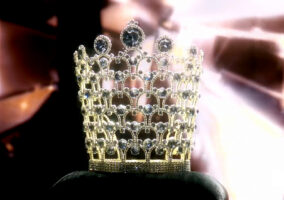Like a lot of people who pay attention to these sorts of things, we rolled our eyes a bit when this television season’s two Mad Men ripoffs, The Playboy Club and Pan Am, were announced. We immediately declared the former not interesting to us (and judging  by the reviews, we were right on that one), but admitted that our interest was piqued for the latter. We noted at the time that both shows had a somewhat unnerving undertone of romanticizing a time when women were expected to be nothing but a subservient visual treat to men. We weren’t exactly wrong on that last point but Pan Am at least has a little more going on than lovingly depicting Camelot-era gender roles.
by the reviews, we were right on that one), but admitted that our interest was piqued for the latter. We noted at the time that both shows had a somewhat unnerving undertone of romanticizing a time when women were expected to be nothing but a subservient visual treat to men. We weren’t exactly wrong on that last point but Pan Am at least has a little more going on than lovingly depicting Camelot-era gender roles.
The show immediately (and repeatedly) makes the point that being a Pan Am stewardess isn’t just glamorous, it’s also a way for women of the period to take some control of their destiny, see the world, and put off the shackles of marriage for a little while longer. Of course you could say the same thing about entering a convent – with the added bonus of not having to be submitted to weight and girdle checks – but Pan Am rather deftly avoids delving too deep into social commentary and frankly, the show is better for it. Is this feminism? No. This is escapism; glossy, glorious, technicolor escapism with a little bit of sex and a little bit of Cold War-era spying to sweeten the pot.
In one hour of television we’re treated to scenes set in New York, Havana, Rome, and London and introduced to the 4 main characters. Christina Ricci’s Maggie is a beatnik living in the village who recently got suspended for violating the girdle rule (which sounds like a euphemism for something); Laura is the sweet and inexperienced stewardess who ran out of her own  wedding with the help of her sister Kate, who is the more experienced stewardess and, unbeknownst to her cohorts, working for U.S. Intelligence as a spy; and Colette is the sexually free (of course) French girl who learns in this episode what happens to girls who sleep with married men. These are all very broad character types – rebel, virgin, smart girl, libertine – but that’s perfect for an introduction. You get who these characters are with a minimum of introduction and the combination of character types makes for potentially interesting stories and interactions. There’s also – and we admit, we might be too optimistic here – the promise that all of this will be built up; that none of these 4 characters will necessarily stay within the box provided for them.
wedding with the help of her sister Kate, who is the more experienced stewardess and, unbeknownst to her cohorts, working for U.S. Intelligence as a spy; and Colette is the sexually free (of course) French girl who learns in this episode what happens to girls who sleep with married men. These are all very broad character types – rebel, virgin, smart girl, libertine – but that’s perfect for an introduction. You get who these characters are with a minimum of introduction and the combination of character types makes for potentially interesting stories and interactions. There’s also – and we admit, we might be too optimistic here – the promise that all of this will be built up; that none of these 4 characters will necessarily stay within the box provided for them.
Christina Ricci is surprisingly under-utilized in this episode but in retrospect, it makes sense. She would have sucked all the oxygen out of the room and rendered every other character in a supporting role had they put the focus on her in the pilot episode. Instead, she’s the brightly lit background character at the moment; the one who’s not driving the action or given a major scene but manages to garner most of the attention simply by virtue of being the biggest star in the cast. It’s too early to say who else in the cast is going to shine, but Kate and Laura got the most screen time this episode and did the most with it. Laura’s perhaps a bit too unsure of herself to be interesting yet, but Kate’s quite the pistol and we were surprised by how effectively tense the “spying” scenes were. You’d expect a show like this to be nothing but sex and soap opera plotlines – and to be fair, it mostly is so far – but the spying subplot, which we originally pegged as silly when we first heard of it, actually deepens the show and makes it more interesting.
Social commentary and historical context seem largely absent outside of sets and costumes (and not even then, in some cases). Hopefully, without sounding like  we’re championing the depiction of a lily-white world of pre-feminism, we think that’s largely for the best. Mad Men does a fantastic job of exploring in great depth the ennui and angst of the mid 20th Century, as well as highlighting the enormous differences between Now and Then while also drawing a line connecting the two. Pan Am doesn’t seem remotely interested in doing such a thing. In the entire hour, we think we saw only one or two people smoking. Contrast that with the first episode of Mad Men, which could have been sponsored by Febreze, so loaded with smoke and ashtrays was it. Accuracy as to the social mores of the day is only going to get lip service here. The focus is on big soapy plots, glamorous locations, and pretty clothes. This isn’t a dark, occasionally depressing look at the sixties, this is a brightly lit, candy colored CGI version of the decade and so long as they keep it light, we’re fine with that. It’s okay to have a little fun with the decade and it’s even okay to make accuracy a backseat concern. We have no doubt that the show will do its best to tip its hat to the downsides of living in a pre-Civil Rights, pre-Women’s Lib era, but it doesn’t seem to want to make that the focus of the show and to be honest, if they did make the attempt, we have a feeling the whole conceit would collapse.
we’re championing the depiction of a lily-white world of pre-feminism, we think that’s largely for the best. Mad Men does a fantastic job of exploring in great depth the ennui and angst of the mid 20th Century, as well as highlighting the enormous differences between Now and Then while also drawing a line connecting the two. Pan Am doesn’t seem remotely interested in doing such a thing. In the entire hour, we think we saw only one or two people smoking. Contrast that with the first episode of Mad Men, which could have been sponsored by Febreze, so loaded with smoke and ashtrays was it. Accuracy as to the social mores of the day is only going to get lip service here. The focus is on big soapy plots, glamorous locations, and pretty clothes. This isn’t a dark, occasionally depressing look at the sixties, this is a brightly lit, candy colored CGI version of the decade and so long as they keep it light, we’re fine with that. It’s okay to have a little fun with the decade and it’s even okay to make accuracy a backseat concern. We have no doubt that the show will do its best to tip its hat to the downsides of living in a pre-Civil Rights, pre-Women’s Lib era, but it doesn’t seem to want to make that the focus of the show and to be honest, if they did make the attempt, we have a feeling the whole conceit would collapse.
And with that hilariously glossy and glamorous final shot of the four leads doing their very best slow motion version of a (literal) runway walk, the message of this pilot comes through loud and clear: This isn’t Mad Men; these are Fab Women.
RZP: Activate the Rachel Signal! Next Post:
“21”
Please review our Community Guidelines before posting a comment. Thank you!



